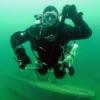Not necessarily...
Most River Caver's here are diving Sidemount steelie dubs WET, not dry...supposedly no issues...
nhbSo, from what I'm reading (thanks for all the comments - they are great!)
if I decide to go with steel tanks, then I'd most likely need to dive dry to have any positive lift. Correct?
again Thanks!!
True... I have begun replacing my LP steel cylinders with Fabres as they are much better for sidemount cave diving. They come closer to "floating" next to the body instead of dragging downward destroying your profile.
FG... I had a female student that we set up with a set of Fabre 85's in doubles configuration that worked great for her personally. You have more to worry about when you dive with someone that uses larger tanks as you have to compute your tank turn pressures based upon your partner's need for your extra 1/3 of gas... if you have smaller capacity, or the other way around if the role's reversed. I may not have made this perfectly clear, but point is that you are diving doubles and probably will be diving in situations where you follow rule of thirds. Your last third MUST be enough and preserved for your buddy. I'm simplifying this... but someone can add to this that has more time. Sometimes, getting small tanks that work for you and your SAC rate, may not be suitable for diving with someone else if they will need a much greater volume of gas in an emergency air sharing situation when breathing off your tanks along with you.














